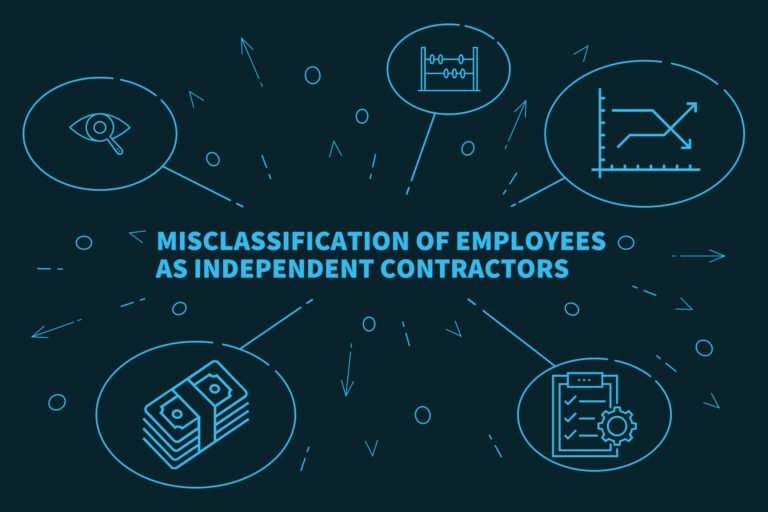In January 2024, the Department of Labor published the Final Rule on Independent Contractor (IC) status. The TechServe Government Affairs Team continues to follow several pending lawsuits and potential Congressional action to review the Rulemaking process. Despite these attempts to block implementation, experts predict that the 2024 IC Rule will go into effect as scheduled on March 11, 2024.
To help keep our members up to date on current regulatory requirements, here’s a checklist to determine independent contractor versus employee status for labor and tax law purposes. For more information, refer to our blog, “Balancing Act: Weighing the risks and rewards of independent contractor relationships in staffing.”
Correctly classifying workers as employees or independent contractors is essential for a company to comply with various federal and state laws, including the federal Fair Labor Standards Act (FLSA). In general, independent contractors do not receive the same benefits and protections under federal law as employees. For example, independent contractors are not:
- Protected by the FLSA’s minimum wage and overtime requirements;
- Eligible for job-protected leave under the federal Family and Medical Leave Act (FMLA);
- Entitled to the National Labor Relations Act’s (NLRA) rights to organize and bargain collectively and engage in other protected concerted activity; or
- Subject to the Affordable Care Act’s employer mandate requirement, which generally requires applicable large employers to offer affordable health coverage to full-time employees or risk tax penalties.
In addition, employers are not required to withhold or pay any taxes on payments to independent contractors.
Classifying workers as either employees or independent contractors is not always a simple or straightforward task. Unfortunately, there is no single standard or test for an employer to use. The U.S. Department of Labor (DOL) has finalized a new economic reality test to determine worker status under the FLSA and FMLA. However, for purposes of federal tax laws, employee benefit laws and the NLRA, agencies and courts have adopted a common-law test. Additional standards may apply for state law purposes, including for worker’s compensation programs.
This cheat sheet outlines the DOL’s economic reality test for classifying workers. It also includes the IRS’ description of the common law test for determining worker status. Employers, including engineering staffing firms, can use this information to help confirm they are considering the relevant factors when classifying workers. Misclassifying an employee as an independent contractor can have serious financial and legal consequences for an employer. Accordingly, employers are encouraged to seek legal counsel to address specific issues and concerns.
Economic Reality Test: FLSA and FMLA
A final rule issued by the DOL’s Wage and Hour Division implements a new standard for worker classification under the FLSA, effective March 11, 2024. The final rule applies six economic reality factors to analyze employee or independent contractor status under the FLSA. No single factor (or set of factors) automatically determines a worker’s status as either an employee or an independent contractor. Instead, the economic reality factors are all weighed to assess whether a worker is economically dependent on a potential employer for work according to the totality of the circumstances.
Additional factors may be relevant in determining whether the worker is an employee or independent contractor for purposes of the FLSA if the factors indicate whether the worker is in business for themselves, as opposed to being economically dependent on the potential employer for work.
The FMLA uses the same framework for worker classification as the FLSA.
Economic Reality Factors
- Opportunity for profit or loss depending on managerial skillThis factor considers whether the worker has opportunities for profit or loss based on managerial skills that affect the worker’s economic success or failure in performing the work. The following facts, among others, can be relevant:
- Whether the worker determines or can meaningfully negotiate the charge or pay for the work provided;
- Whether the worker accepts or declines jobs or chooses the order and/or time in which the jobs are performed;
- Whether the worker engages in marketing, advertising or other efforts to expand their business or secure more work; and
- Whether the worker makes decisions to hire others, purchase materials and equipment, and/or rent space.
If a worker has no opportunity for a profit or loss, then this factor suggests the worker is an employee.
- Investments by the worker and the employerThis factor considers whether any investments by a worker are capital or entrepreneurial in nature. Costs to a worker of tools and equipment to perform a specific job, costs of the worker’s labor and costs that the potential employer imposes unilaterally on the worker, for example, are not evidence of capital or entrepreneurial investment and indicate employee status. Investments that are capital or entrepreneurial in nature and thus indicate independent contractor status generally support an independent business and serve a business-like function, such as increasing the worker’s ability to do different types of or more work, reducing costs or extending market reach.
- Degree of permanence of the work relationshipThis factor weighs in favor of the worker being an employee when the work relationship is indefinite in duration, continuous or exclusive of work for other employers. This factor weighs in favor of the worker being an independent contractor when the work relationship is definite in duration, nonexclusive, project-based or sporadic based on the worker being in business for themselves and marketing their services or labor to multiple entities. This may include regularly occurring fixed periods of work, although the seasonal or temporary nature of work by itself would not necessarily indicate independent contractor classification.
- Nature and degree of controlThis factor considers the potential employer’s control, including reserved control, over the performance of the work and the working relationship’s economic aspects. Facts relevant to the potential employer’s control over the worker include whether the potential employer sets the worker’s schedule, supervises the performance of the work, or explicitly limits the worker’s ability to work for others. Additional relevant facts include whether the potential employer uses technological means to supervise the performance of the work (such as using a device or electronical monitoring), reserves the right to supervise or discipline workers, or places demands or restrictions on workers that do not allow them to work for others or work when they choose.Whether the potential employer controls economic aspects of the working relationship, including prices or rates for services and the marketing of the services or products provided by the worker, should also be considered. Actions taken by the potential employer for the sole purpose of complying with a specific, applicable federal, state, tribal or local law or regulation are not indicative of control. Actions taken by the potential employer that go beyond compliance with a specific, applicable federal, state, tribal or local law or regulation and instead serve the potential employer’s own compliance methods, safety, quality control, or contractual or customer service standards may be indicative of control.
- Extent to which the work performed is an integral part of the employer’s businessThis factor considers whether the work performed is an integral part of the potential employer’s business. This factor does not depend on whether any individual worker is an integral part of the business but rather whether the function they perform is an integral part of the business. This factor weighs in favor of the worker being an employee when the work they perform is critical, necessary or central to the potential employer’s principal business. This factor weighs in favor of the worker being an independent contractor when the work they perform is not critical, necessary or central to the potential employer’s principal business.
- Skill and initiativeThis factor considers whether the worker uses specialized skills to perform the work and whether those skills contribute to business-like initiative. This factor indicates employee status when the worker does not use specialized skills to perform the work or is dependent on training from the potential employer to perform the work. Where the worker brings specialized skills to the work relationship, this fact is not indicative of independent contractor status because both employees and independent contractors may be skilled workers. It is the worker’s use of those specialized skills in connection with business-like initiative that indicates that the worker is an independent contractor.
Common-law Test – Federal Tax Law, ERISA and NLRA
A common-law test applies to determine whether a worker is an employee or independent contractor for purposes of federal tax law, employee benefits law (ERISA) and the NLRA. In general, the common-law test involves looking at various factors regarding the relationship between the parties, including the degree of control and independence between the parties.
Businesses must weigh all these factors when determining whether a worker is an employee or independent contractor. Some factors may indicate that the worker is an employee, while others indicate that the worker is an independent contractor. Also, factors relevant in one situation may not be relevant in another.
To help employers make this determination for federal tax purposes, the IRS has grouped the common law factors into three categories: (1) behavioral control, (2) financial control and (3) the relationship between the parties.
Common-law Factors
Behavioral control
Facts that show whether the business has a right to direct and control how the worker does the task for which they were hired.
A Instructions the business gives to the worker
An employee is generally subject to the business’s instructions about when, where and how to work. The amount of instruction needed varies among different jobs. Even if no instructions are given, sufficient behavioral control may exist if the employer has the right to control how the work results are achieved. A business may lack the knowledge to instruct some highly specialized professionals. In other cases, the task may require little or no instruction. The key consideration is whether the business has retained the right to control the details of a worker’s performance or instead has given up that right.
B Training that the business gives to the worker
An employee may be trained to perform services in a particular manner. Independent contractors ordinarily use their own methods.
Financial controlFacts that show whether the business has a right to control the business aspects of the worker’s job.
A The extent to which the worker has unreimbursed business expenses
Independent contractors are more likely to have unreimbursed expenses than employees. Fixed ongoing costs that are incurred regardless of whether work is currently being performed are especially important. However, employees may also incur unreimbursed expenses in connection with the services they perform for their employer.
B The extent of the worker’s investment
An independent contractor often has a significant investment in the facilities or tools they use in performing services for someone else. However, a significant investment isn’t necessary for independent contractor status.
C The extent to which the worker makes their services available to the relevant market
An independent contractor is generally free to seek out business opportunities. Independent contractors often advertise, maintain a visible business location, and are available to work in the relevant market.
D How the business pays the worker
An employee is generally guaranteed a regular wage amount for an hourly, weekly or other period of time. This usually indicates that a worker is an employee, even when the wage or salary is supplemented by a commission. An independent contractor is often paid a flat fee or on a time and materials basis for the job. However, it is common in some professions, such as law, to pay independent contractors hourly.
E How the business pays the worker
Having the possibility of making a profit or incurring a loss indicates that the worker is an independent contractor.
Type of relationship
Facts that show the type of relationship between the worker and the employer.
A Written contracts
Written contracts describe the relationship the parties intend to create. Although a contract may state that the worker is an employee or an independent contractor, it is not sufficient to determine the worker’s status. How the parties work together determines whether the worker is an employee or independent contractor.
B Employee benefits
This factor depends on whether the business provides the worker with employee-type benefits, such as insurance, a pension plan, vacation pay or sick pay. Businesses generally do not grant these benefits to independent contractors. However, a lack of these benefits does not necessarily mean the worker is an independent contractor.
C The permanency of the relationship
If an employer engages a worker with the expectation that the relationship will continue indefinitely rather than for a specific project or period, this is generally considered evidence that the employer’s intent was to create an employer-employee relationship.
D The extent to which services performed by the worker are a key aspect of the regular business of the company
If a worker provides services that are a key aspect of an organization’s regular business activity, it is more likely that the company has the right to direct and control their activities. For example, if a law firm hires an attorney, it is likely that it will present the attorney’s work as its own and would have the right to control or direct that work. This would indicate an employer-employee relationship.
In addition, there are certain types of employees that must be treated as employees or nonemployees under federal tax law. For more information on worker classification for federal tax purposes, see IRS Publication 15-A.












